

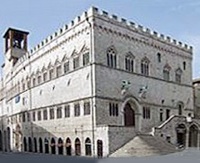
The first public palace of Perugia was the Palazzo del Podestà (1205-6). When the new magistracy of the Capitano del Popolo was introduced in 1255 alongside that of the Podestà, a nearby tower house in Via della Gabbia that belonged to “Madonna Dialdana” (see below) was rented for his use.
The first discussion of the possibility of building a new palace for this magistracy (the "Palatium Novum Populi") seems to have taken place in 1273. However, the project had to give way to other projects:
-
✴the restoration of the aqueduct from Monte Pacciano (which had been blocked since 1262) and the construction of the Fontana Maggiore in 1278 and Fontana Minore in 1281; and
-
✴the extension of Palazzo del Podestà in 1282-92.
Meanwhile, the tower house of “Madonna Dialdana” was adapted by the incorporation of other adjoining properties, and further properties were leased so that they could subsequently be acquired and demolished to make way for the construction of the new palace.
Original Building (1293-7)
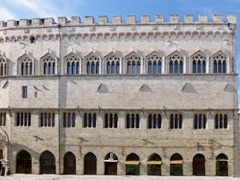
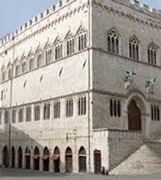
In 1292, the Rettori delle Arti resolved to acquire the rented properties mentioned above so that work could begin on the new palace for the Capitano del Popolo. The otherwise unknown Giacomo di Servadio and Giovanello di Benevento designed the original rectangular core of this palace, which comprised three bays in Piazza Grande (now Piazza IV Novembre) and and ten bays along what is now Corso Vannucci. Each of the two main floors comprised a single room with trifore windows along two sides:
-
✴The room on the lower floor was originally the Sala del Consiglio, the room used for meetings of the Council that advised the Capitano del Popolo. It later became the Sala dei Notai (below).
-
✴The room above it now forms the Sala Podiani of the Galleria Nazionale.
The ground floor loggia along Corso Vannucci was divided into units and rented out.
Lion and Griffin (1274)
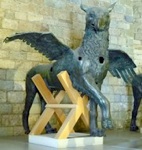
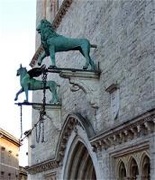

The Commune probably commissioned these magnificent bronze statues in 1274 for use in the annual procession on the feast of St Herculanus: this procession from the Duomo to San Domenico and back was first documented in 1276, when they were in “eglesia Sancti Laurenzii et Sancti Herculani” (the Duomo). An artist known as the Maestro del 1274 cast each of them in a single piece. The griffin's wings were added in 1281, at which point both figures were gilded.
The figures were placed on detachable mounts on the Fontana Minore from 1281 until 1301, and presumably continued to be used in the processions throughout this period. They were removed from the fountain and placed above the external portal of what is now known as the Sala dei Notai in 1301.
The figures were removed for restoration in 1951 and returned to their original locations in 1973.
-
✴They were replaced by copies (illustrated at the centre above) in 1985.
-
✴The originals (illustrated to the sides above) were exhibited in the Galleria Nazionale. However, at the time of my visit in 2013, they were temporarily located in the enclosed courtyard through the Portale dei Santi Patroni (see below).
Sala dei Notai
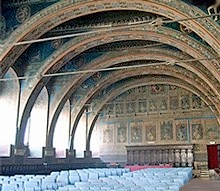
As noted above, this room on the lower of the two main floors of the palace was originally the Sala del Consiglio, the room used for meetings of the Council that advised the Capitano del Popolo. It was re-designated as the Sala dei Notai in 1583, when it became the premises of the Collegio dei Notai (the guild of public notaries).
The room is spanned by eight huge wooden arches that support the ceiling.
Frescoes (1298-1300)
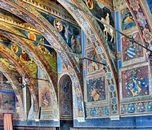
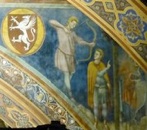
The frescoes on the spandrels of the arches are usually are attributed to the workshop of the Roman artist Pietro Cavallini. The date of their execution can be deduced from two coats of arms:
-
✴those represented five times on the frescoes nearest to the back wall are those of Bonifacio Boiardi, who was Capitano del Popolo in 1298; and
-
✴those represented four times on the frescoes nearest to the entrance are those of Schiatta dei Cancellieri, who was Capitano del Popolo in 1299/1300.
The subjects depicted include:
-
✴scenes from the Old Testament;
-
✴a series that seem to depict scenes from Aesop's fables; and
-
✴a series that probably represents scenes of knightly chivalry.
The arms of serving Podestà and Capitani del Popolo were routinely added to the collection that covers the walls until the mid-15th century. The earliest to survive (to the left of the entrance) are those of Tavena dei Tolomei de Siena, Podestà in 1296/7.
Extension of Palace in 14th Century
The Commune seems to have decided to extend the palace soon after its completion, and Pope Boniface VIII approved the transfer of the adjacent church of San Severo (in Piazza Grande) for the purpose in 1298. However, San Severo belonged to the canons of San Lorenzo, and they were not immediately inclined to co-operate. Expansion along Corso Vannucci seemed an easier prospect, and the Commune began acquiring the necessary properties there from 1300.
Matters became pressing when the government of the Priori delle Arti was instituted in 1303. The Priors initially occupied some of the recently-purchased houses in Corso Vannucci. However, many of these burned down in 1315, and the decision was taken to rebuild from scratch. Ambrogio Maitani probably supervised the project from 1317, the year in which he was appointed as city architect.
Extension along Corso Vannucci
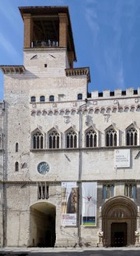
The Commune then bought the tower house on the other side of Via dei Priori from Cola di Benvenuto Servitori in ca. 1330. This phase of the work ended in 1331, when the bell tower above was completed. The bells were installed in 1339.
The room above Corso Vannucci served as the Sala del Consiglio. This was the site of the Priors' fateful decision in 1375 to release prisoners of war who later defeated the city. The room was subsequently known colloquially as the Sala del Malconsiglio.
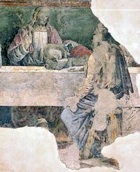
Portale dei Santi Patroni (early 14th century)
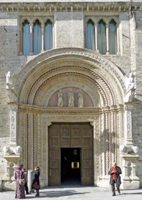
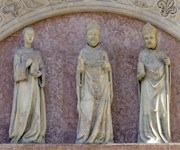
This part of the palace was completed by the construction of a monumental entrance to the atrium of the new palace, which breaks into two of the trifore windows of the Sala del Consiglio above. Ambrogio Maitani is usually credited with its design. Two lions support the side pilasters, while two griffins devouring cows sit at the ends of the architrave. The latter are the symbols of the Arte dei Macellai (butchers’ guild), which presumably financed the work.
Ambrogio Maitani is also usually credited with the carving of the originally polychrome marble figures of in the lunette. They probably represent SS Herculanus, Laurence and Constantius, who were named together as the patron saints of Perugia in 1316. The figures were removed for restoration in 1993 and moved to the Galleria Nazionale. Copies (illustrated here) were placed in the original location above the portal.
Extension in Piazza Grande
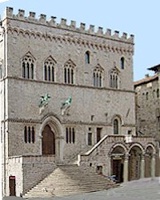
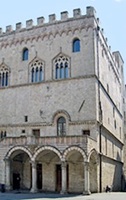
The Commune finally took possession of San Severo in 1319. (In return, it financed a new church that was probably built on the site of an earlier one dedicated to St Agatha, which became SS Severo e Agata). It was initially rented out for commercial purposes, while work on extending the palace concentrated on the extension along Corso Vannucci (above).
In 1326, Ambrogio Maitani began the construction of the steps to the entrance to the priors’ residence in Piazza Grande (the first room of which later became the Sala dei Notai - above). The priors moved into their new accommodation shortly thereafter.
In 1333, he turned his attention to the accommodation of the Capitano del Popolo. He extended the palace in Piazza Grande by incorporating the deconsecrated church of San Severo, the Torre di Madonna Dialdana (just visible at the extreme right of the photograph on the right) and other adjacent buildings. The combined palaces now assumed occupied a rectangle that extended along Via della Gabbia to Via dei Priori.
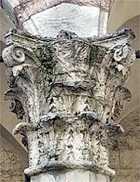
The balcony above the loggia includes a pulpit that was used for proclamations. The upper part of it was removed at some point and restored in the early 20th century. The original staircase from the Piazza was probably rebuilt as part of this project in order to provide access additionally to the balcony.
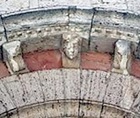
View of Back of Palace
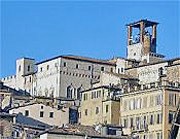
The picture above gives a good impression of the complex as it had evolved during the early part of the 14th century.
-
✴The crenellated extension over San Severo and the Torre di Madonna Dialdana, which together formed an extension to the Palazzo del Capitano del Popolo can be seen on the left.
-
✴The rectangular core of the Palazzo dei Priori and the clock tower that was subsequently built above the tower house of Cola di Benvenuto Servitori can be seen to the right.
Interior of the Palace
The Portale dei Santi Patroni opens onto a huge atrium. An imposing staircase in the bay nearest to the original nucleus leads to the two floors above.
-
✴The new Sala del Consiglio was located on the first floor, overlooking Corso Vannucci.
-
✴Many of the other rooms on this floor and all those on the floor above now house the Galleria Nazionale and are described in the pages on the gallery. For example:
-
•Room 1, the large room known as the Sala Maggiore that occupied the whole of the top floor, provided the most prestigious space in the palace.
-
•The first part of Room 4 was originally the chapel that was built behind the tower of Cola di Benvenuto Servitori as part of the extension of the palace in ca. 1330. This chapel was consecrated in 1331 to SS Louis of Toulouse and Magnus.
Petra Justitiae (Stone of Justice) (1234)
This inscription was carved on a marble plaque from a Roman building to record the terms of a settlement that was reached between the nobles and the popolani of Perugia under the auspices of the Podestà Rambertus de Ghisleriis after a long civil war. The popolani emerged victorious, and as a sop to their opponents agreed that all past financial obligations to the Commune should be extinguished. This marked the transition from government by (noble) Consuls to that by a series of foreign Podestàs.
The inscription was originally set into the base of the campanile of the Duomo but was subsequently moved in the Sala del Consiglio. A copy has been set into the wall of the right transept of the Duomo, under the Loggia di Braccio, close to the original location.
Madonna and Child with angels (1486)
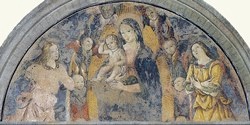
This damaged fresco, which is the earliest documented work by Pintoricchio, was painted in the lunette of the portal that led to the Priors' dormitory. It was subsequently moved to the Sala del Consiglio. It depicts a half-length, standing Madonna and Child in a mandorla of putti, with standing angels to the sides. Pintoricchio must have returned briefly from Rome in order to make his contribution to what was probably largely a workshop production.
Palazzo dei Priori in the Period 1365-1424
The Perugians defeated a mercenary army that threatened their city at the Battle of San Mariano (1365). However, at a meeting held shortly afterwards in the Sala del Consiglio, the Priors decided to free most of their prisoners, and awarded citizenship to two of them, Albert Sterz and Andrew Belmonte (August 1366). When the former betrayed the city soon after, he was arrested and executed (November 1366). Andrew Belmonte, who was also still in Perugian service, immediately defected to the mercenray army of his fellow Englishman, John Hawkwood, taking the advance he had received on his salary with him. The English mercenaries marched on Perugia and defeated its army at the Battle of Brufa, near Ponte San Giovanni, in March 1367. The Perugians lost more than 1,000 soldiers and had to pay an enormous sum in “reparations”. The room in which the decision to free Stertz and Belmonte became known as the “Sala del Malconsiglio” (room of bad counsel).
In 1373-5, The papal legate Gérard du Puy, Abbot of Marmoutier, (known to the Italians as “Monmaggiore”) commandeered Palazzo dei Priori and built a fortified corridor that linked it to his new Fortezza di Porta Sole. The building of this corridor disrupted the project to rebuild the Duomo, and resulted in the destruction of the original campanile.
The Priori delle Arti regained possession when the papal forces were expelled from the city in 1375. The Collegio della Mercanzia, which was the most important of the guilds, received two of the leased units on the ground floor of the palace (now 15-17 Corso Vannucci) in 1390 in settlement of a debt and established its headquarters here.
They retained at least their nominal power and the use of their palace under the later lords of Perugia:
-
✴Biordo Michelotti (1393-8) continued to live in his family palace in what is now Piazza Biordo Michelotti; and
-
✴Braccio Fortebracci (1414-24) used the ex-Palazzo del Podestà as his residence. Braccio did however abolish the office of Capitano del Popolo, and it was probably at this point that the whole palace became known as the Palazzo dei Priori.
Extension along Corso Vannucci (1429-73)
The growth in the bureaucracy of Perugia in the early 15th century necessitated further expansion along Corso Vannucci. This required the purchase of properties beyond the tower house of Benvenuto di Cola dei Servitori from the Benedictine Abbazia di San Paolo di Valdiponte. The properties in question extended as far as the ancient church of San Giovanni del Mercato. Pope Paschal II had confirmed this church as a possession of the Abbazia di San Paolo di Valdiponte in 1110, and it had been recorded as a parish church in 1285. The abbey had subsequently acquired the adjoining properties and leased them to commercial enterprises.
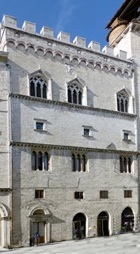
This extension was executed in an anachronistic style that preserved the harmony of the integrated structure of the palace. In ca. 1450, a room at the back on the top floor was adapted as the new Cappella dei Priori (now Room 21 of the Galleria Nazionale).
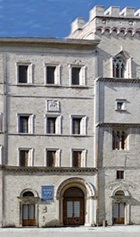
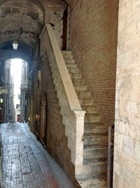
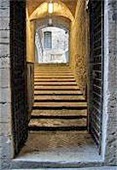

Steps on the right further along Via Boncambi (just past number 7) lead down to an inner courtyard of the palace that formed part of the extension of 1429-43. The tripartite relief on the left at the top of these steps contains:
-
✴the arms and bishop's mitre of Bartolomeo di Cuzio;
-
✴the double cross that records his position as prior of the Canons of the Holy Sepulchre; and
-
✴an inscription that records a program of work that he commissioned in 1363, which probably involved the construction or renovation of the hospice at Santa Croce.
After the Salt War (1540)
Before the Salt War, the papal governors of Perugia had lived in the ex-Palazzo del Podestà, but this was burned down in the riots of 1534. The city magistrates vacated the top floor of the palace soon after to make way for the papal legates. A new legatine palace was subsequently built in Rocca Paolina, but the legates also needed space in Palazzo dei Priori.
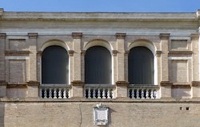
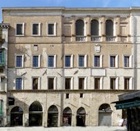
The work was carried out under Galeazzo Alessi, after his to Perugia just before his death in 1572:
-
✴He was paid in 1570 for work in relation to the restructuring of the bell tower.
-
✴He was paid again in 1572 for the restructuring of a room in the palace (probably what is now the Sala Rossa), together with the loggia behind the rooms over the Collegio del Cambio (at the back of the palace, now Room 19 of the Galleria Nazionale).
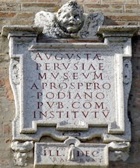
Later History
The Lippi family built Palazzo Lippi-Alessandri beyond Via dei Pentolini in the 17th century. The street was vaulted in 1790 to support three storeys: the lowest was added to Palazzo Lippi and the upper two to the apartments of the papal governors in Palazzo dei Priori. The area under the vaults was subsequently incorporated into Palazzo Lippi.
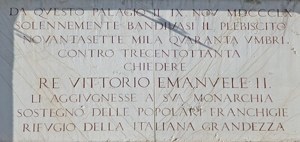
The inscription below the one mentioned above records that the result of the plebiscite of 4th November 1860 was announced from the palace. The people of Umbria voted by 97,040 to 380 to join the new kingdom of Italy under King Vittore Emanuele II.
The Palazzo dei Priori underwent a long and difficult restoration in 1862-1936 that restored it to something like its original appearance.
The top two floors of the palace now house the Galleria Nazionale, while the rest of the building is still used by the municipal government.
Read more:
F. Mancini (Ed), “Il Palazzo dei Priori di Perugia”, (2000) Perugia
Return to Monuments of Perugia.
Return to Walk I.

